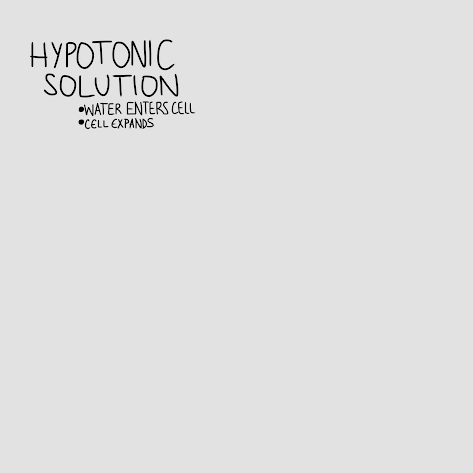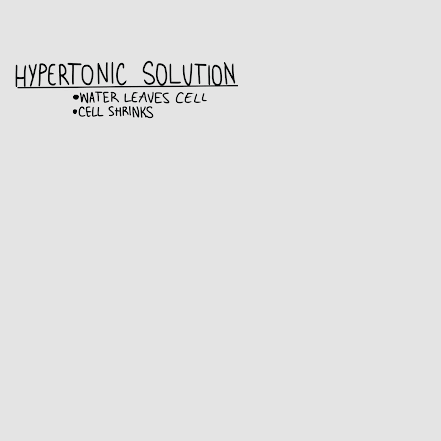Tonicity
Tonicity is the ability of a surrounding solution to cause a cell to gain or lose water.
A hypotonic solution refers to a solution that, when surrounding a cell, causes the cell to gain water. This is because there is more solute inside the cell than outside the cell. In Greek, 'hypo' means less. Since there are more solutes inside the cell than outside, water will move into the cell.
A hypertonic solution refers to a solution that, when surrounded a cell, causes the cell to lose water. This is because there is less solute inside the cell than outside the cell. In Greek, "hyper" means more. Since there are more solutes outside the cell than inside, water will move out of the cell.
An isotonic solution refers to a solution that, when surrounding a cell, doesn't induce any change in the water content of the solution or cell. This is because there are equal amounts of solute inside and outside the cell, so there will be no net movement of water.
Remember how animal cells do not have a cell wall like plant cells? This means that when the animal cell gets too much water inside the cell, there's no cell wall stopping it from bursting apart. Lysis is the process of a cell bursting open from too much water. If a cell is in a hypotonic solution, water will move into the cell very quickly. The cell will keep gaining and gaining water until it bursts apart. It will become lysed. (The past tense form of lysis is lysed).
In the case of the plant cell, which has a cell wall, an intake of water, no matter how much, will not burst the cell. The term for a plant cell which has a lot of water is turgid. Plant cells will generally prefer to be turgid and very full of water. So, a large intake of water is harmful for animal cells but not plant cells.
A plant cell that has what would have what is considered a "normal" amount of water for an animal cell would be considered flaccid because there is less water in the plant cell than it would generally like.
An animal cell in a hypertonic solution will lose a lot of water and become shriveled. It loses so much water that the cell will shrink from all the water loss.
A plant cell in a hypertonic solution will lose a lot of water and become plasmolyzed (another term for shriveled, but specific to only plant cells). The membrane and cytoplasm loses so much water that it will shrink, and in the process, pull away from the cell wall, like so.
That's it!








So a lysosome also does lysis? does it do this by forcing the cell to take in water until it explodes?
ReplyDeleteNot quite! The lysosome will leak it's acidic insides into the cell which will destroy the cell, not by taking in water.
DeleteThanks!
DeleteWhat's net movement of water?
ReplyDeleteThe net movement of water is the number of H2O molecules moving in direction with the force minus the molecules going the other way. If 15 water molecules are leaving the cell but 15 molecules are entering the cell, 15-15=0. Therefore there is no net movement of water as they are equal.
DeleteDo the solutes inside the cell ever leave the cell in order to make it equal?
ReplyDeleteTypically no, it's the water that moves.
Deletedoes tonicity only refer to the solution or also to the cell?
ReplyDeleteIt can refer to both! In relation to a hypotonic solution, a cell is hypertonic, and vice versa.
DeleteSo shriveled = plasmolyzed? What's the point of having different words?
ReplyDeleteEssentially, yes. They both mean there was a loss in water, but each word is for a particular type of cell, because each cell (plant or animal) looks different during water loss. An animal cell will curl in on itself when it loses water. A plant cell's membrane will curl in on itself too, but the cell wall will remain where it is.
DeleteI like the gif format! the animations helped me understand the concept better - can you use more gifs in the future? thank you!
ReplyDeleteOf course! I was testing out if animations would improve understanding and it sems to work :)
Deleteif a plant cell remains flaccid for a long time will the plant die?
ReplyDeleteIf majority of cells in a plant remain flaccid the plant will wilt, and if it stays wilted for a long time, it will die because it won't continue growth and photosynthesis. So, yes.
Delete